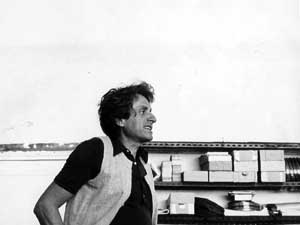|
||||||||||||||||||||||||
|
An architect and a musician 建筑师和音乐家
|
Appendixes: 附录 Iannis Xenakis官方网站 专辑目录 (PDF) |
Audios online 音频在线 Sample albums on CD Universe 
Sample albums on All of Mp3
Sample albums on VH1 
|
||||||||||||||||||||||
|
简 介 Iannis Xenakis是二十世纪最激进和最重要的作曲家之一,使他出名的革命性观念包括他对音乐组织的系统化和数学性的理解,以及他将音乐结构与建筑所做的比照。他还是电子音乐发展过程中的一个决定性人物。 Iannis Xenakis出生于罗马尼亚,是一个年轻的共产主义者。他的周围到处都是罗马尼亚民间音乐,还有拜占庭东正教的礼拜仪式。1942年全家搬到希腊,他第一次接触到了贝多芬和勃拉姆斯的音乐。 Iannis Xenakis先是在雅典理工学院学习土木工程,德国入侵及英国占领后他满腔热情地加入抵抗运动和解放组织。他因此受了重伤,并在后来被判死刑。 1947年他成功逃脱来到法国,开始了建筑师的职业生涯,成为Le Corbusier的助手。对他来说,建筑就是音乐,音乐就是建筑。1954年Iannis Xenakis创作了他的第一部音乐作品Metastasis,这是根据为1958年布鲁塞尔博览会所做的Philips pavilion的外观设计而完成的。 数学、工程和设计背景以及对复杂声音现象的兴趣为他提供了有益的帮助,Iannis Xenakis摒弃十二音阶作曲法的束缚,按照自己的方式把声音从所有的先验规则中解放出来。他在作曲中引入了概率论,以此作为控制由无数个体组成的大范围事件的手段。其结果就是高度理论性和系统化的音乐,它有着预先计算出的杂乱的节奏、稠密的经常爆发的质地、被扩展的音色,还有数不清的“颗粒”组成的声音之“云”。 |
Brief introduction Iannis Xenakis is one of the most radical and important composers of the twentieth century who is known for his revolutionary ideas regarding the systematic, mathematical organization of music and its structural parallels with architecture. He's also one of the crucial figures in the development of electronic music. Iannis Xenakis born in Romania, as a young communist. He was surrounded by the folk music of the Romanian countryside and the liturgy of the Byzantine Orthodox Church. In 1942, when his family settled in Greece, he was exposed to the music of Beethoven and Brahms for the first time. He studied civil engineering at the Athens Polytechnic, but after the German invasion and the British occupation Iannis Xenakis passionately involved with resistance and liberation groups, through which his activities led him to be severely wounded and later condemned to death. He escaped in 1947 and fled to France where he started working as an architect, being an assistant of Le Corbusier. For him, architecture was musical, and music was architectural. In 1954 Iannis Xenakis produced his first musical work, Metastasis, based on the design for the surfaces of the Philips pavilion to be built for the Brussels Exposition of 1958. Aided by his background in mathematics, engineering and design, and by his interest in complex sonic phenomena, Iannis Xenakis rejectied the strait-jacket of serialism and followed his own path to liberate sound from all a priori rules. He incorporated probability theory into his compositional approach, as a means of generating and controlling large-scale events composed of massive numbers of individual elements. This resulted in highly theoretical, systematic music characterized by intricately calculated rhythms, dense and often explosive textural fields, extended timbral effects, and "clouds" of sound that contain countless "particles." |
|||||||||||||||||||||||
|
Dec 23, 2006 |
||||||||||||||||||||||||



